Chess Moves
There is much focus in the chess community on chess moves in the opening.
I want you to consider this article which focuses on chess moves in the endgame instead.
I guarantee, that if you master the end game, you'll spend much less time studying the openings and you'll win twice as much. Mastery of the endgame is your key to consistent victory.
Click Here for a Full Chess Moves Video Course on Chess Openings and Endgame Play
When studying chess moves during the endgame, it is a question of primary importance to what extent your pawns can support themselves against attack by the adverse King, and on the other hand how, with their own force, or with the assistance of your King they may be played up to queen. The calculation of distances to the queening square is the foundation upon which all combination must necessary rest. If your adversary has a pawn that can not be stopped you may occasionally compel or allow it to queen in such a position that it will not interfere seriously with the progress of your game. Or you may be able to play one of your own Pawns through opposing forces to the eighth square, by a sacrifice, or exchange, to clear the file. The mutual advance of the side Pawns against each other is also matter upon which the game often turns. If it cannot be decided by any of these preliminary process the usual course is to bring the kings to the front in opposition.
Click Here for a Full Chess Moves Video Course on Chess Openings and Endgame Play
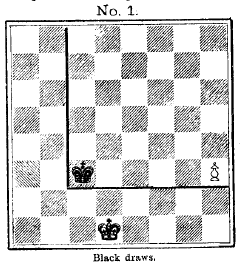 Calculation
of Distance
Calculation
of Distance
The adverse King can always stop a single pawn in an open board, if he stands within the quadrangle of four equal sides formed by the square your passed pawn stands upon and the queening square. Thus in position No. 1 the black King may be placed the square within the cordon, with white to move he may be place a step outside the cordon. This is his utmost limit. Owing to the Pawn you push on being able to go to the fourth line in one move whether it stands on h3 or h2. If the board is not open due allowance must be made for obstruction. A Black pawn at e5 would delay for one move the Black kings arrival at a7, and if white had the first move would lead to the loss of the game.
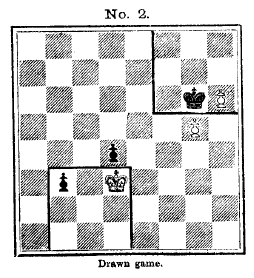 Self-
Supporting Pawns
Self-
Supporting Pawns
Is certain positions two passed Pawns can support themselves against
the adverse king. Nor is it essential that they should be united. In position
2 the game is drawn so long as the pawn are unmoved. Neither king dare
capture the backward Pawn nor leave the forward one beyond the cordon.
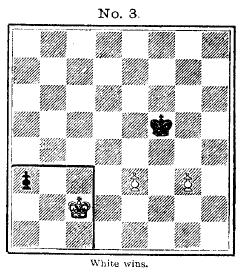 Upon
this principle is founded position 3. if the black King (with the move)
attack either of the white pawns the other one advances and both being then
secured the black pawns must fall.
Upon
this principle is founded position 3. if the black King (with the move)
attack either of the white pawns the other one advances and both being then
secured the black pawns must fall.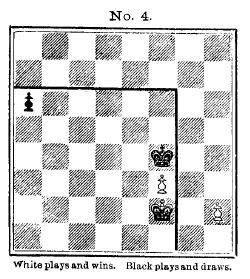 No.4
is another postion of the same class. White having the move plays 1 P-h4
and his king being within the cordon he wins Black's pawn. If however, black
has the move be advances his Pawn and white has only just time to prevent
it queening, leaving his own Pawns to be captured as they stand.
No.4
is another postion of the same class. White having the move plays 1 P-h4
and his king being within the cordon he wins Black's pawn. If however, black
has the move be advances his Pawn and white has only just time to prevent
it queening, leaving his own Pawns to be captured as they stand.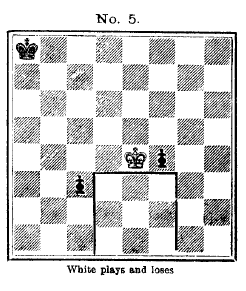 If
the pawns are placed two files apart as in position 5. they will win for
if K-Q3, P-B6; 2K x P, leaving the cordon. It should be noted that this
is the winning limit. If the position of the pawns and The White King
is raised a line the latter has a larger cordon to move in, and wins them
both.
If
the pawns are placed two files apart as in position 5. they will win for
if K-Q3, P-B6; 2K x P, leaving the cordon. It should be noted that this
is the winning limit. If the position of the pawns and The White King
is raised a line the latter has a larger cordon to move in, and wins them
both.
Click Here for a Full Chess Moves Video Course on Chess Openings and Endgame Play